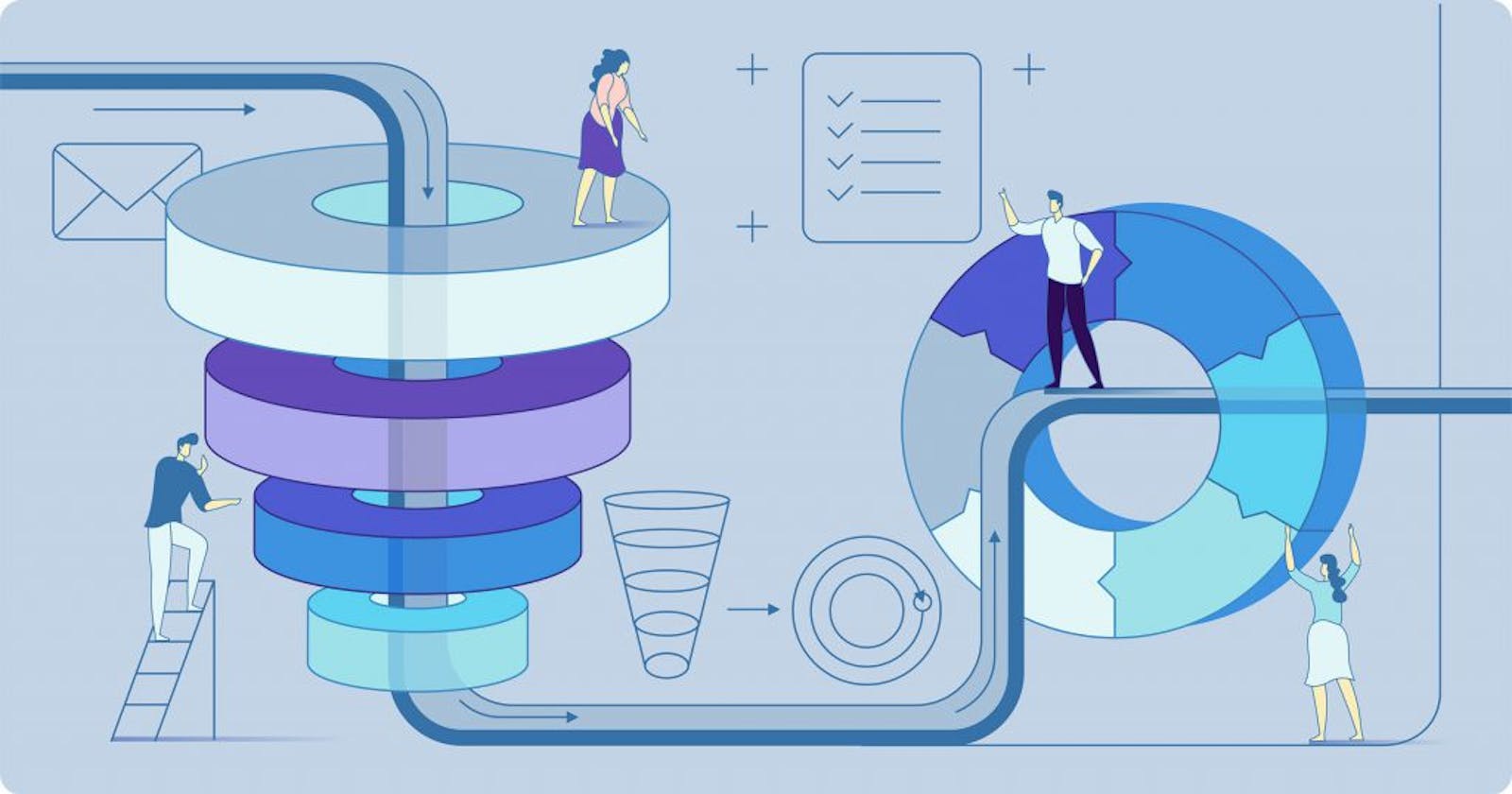Continuous improvement and automation are the key to the success of any business. But how do you know what to automate and what to improve in your business operations? Marketing funnels are among the most easy-to-use yet powerful tools to help you break the customer journey into steps, analyze these steps, spot any bottlenecks and eliminate them.
What is a marketing funnel
A marketing funnel is a visualization of your client’s journey divided into stages – from finding out about what you offer and about your brand to eventually purchasing your product or service.
It’s often referred to as a sales/purchase funnel, conversion funnel, customer journey, or other similar terms. The thing is, all these terms are often used interchangeably. What’s more, all these funnels may have a pretty similar structure depending on the company and business type.
Much confusion is caused by the fact that the same one task can be performed by different departments within different companies and can be approached from a variety of perspectives. For instance, salespeople can end up being responsible for user attraction if there’s no marketing department. So what’s the difference?
Customer journey is an illustration of the steps a person makes while engaging with your company. Customer journey shows the customer perspective and may include such steps as: “visit a shop,” “get a consultation,” etc.
Purchase or sales funnel also demonstrates the path a person goes through to become a customer but from the sales side. For instance, such a funnel can have a stage “Lead qualification” or “send a proposal.” A purchase funnel is often used in pair with a sales pipeline. In this case, the pipeline contains all the stages and is used to move prospects and close deals, while the funnel is needed to see the number of people (prospects) who go through the stages.
Marketing funnel is the oldest and most famous funnel that shows a person’s path from the marketing perspective and includes the efforts the marketing team should make to turn a person into a customer or even a loyal customer. For instance, a marketing funnel may include such activities as “promotion in social media” or “podcast creation” during the “Awareness/Discovery” stage.
Conversion funnel is a path a user takes to make a purchase on an e-commerce website or application. It’s meant to analyze the sales performance of a software product, detect hurdles and bottlenecks, and eliminate them.
Despite the differences, the general concept of all funnels is pretty much the same – breaking down your client’s journey into steps and then tracking and improving how well these steps convert one into another. And since some people naturally drop out at each stage, that visualization resembles a funnel that is wide at the top and narrow at the bottom.
Of course, living in an ideal world, we would have a cylinder, so everyone who finds out about your business would end up paying you for something. And all of your prospects would become your customers, or even returning customers, referring to their friends and promoting your brand by word of mouth.
Unfortunately, that’s not how things work for real businesses. The number of people traveling from discovery to action gets lower as they move down the funnel. And everyone who’s involved in growth on an organization’s side, like marketers, salespeople, product managers, business owners, and many other roles, dedicate significant efforts to making that funnel wider and more cylindrical. Their mission is to acquire and guide as many potential customers as possible towards making the desired action.
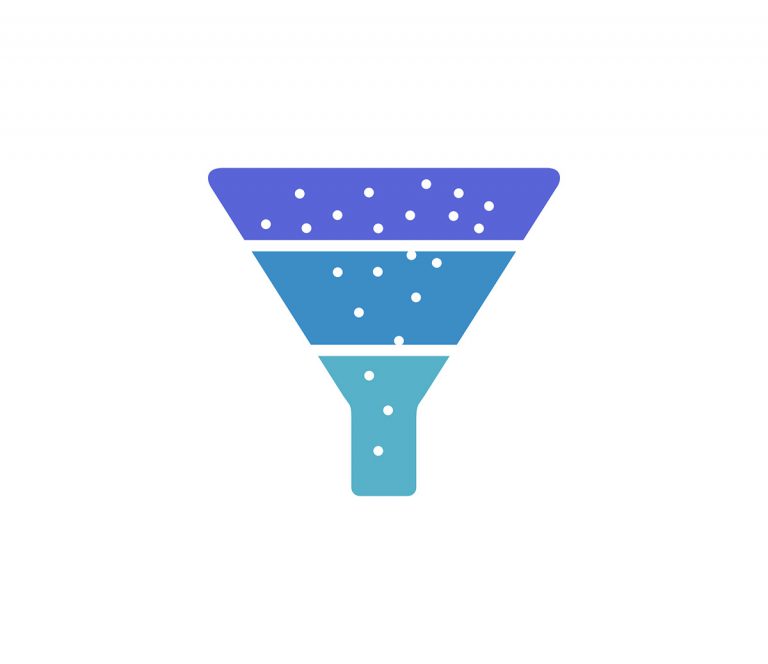
Why your business needs a funnel
There could be numerous reasons why prospects who began their journey with you have not yet become your clients. And it could take you forever to make the right assumption about why that happened.
When breaking down that journey into steps, you significantly increase your chances of making the right guess. As soon as you know the drop-off reason, you can then fix that and get more people to become your clients, therefore, operating more successfully.
Revenue growth is mainly achieved through funnel improvements. So, you should either get more people in there or convert them with more efficiency. That’s the entire point of building and tracking marketing funnels. Apart from gathering insights, regularly tracking your funnel conversions helps to control your business performance and be alerted to any positive and negative changes that may occur at any stage.
Now that you know what significant benefits a funnel can bring to you, you’re probably rushing to build your own funnel and see the big picture right away. But first, it is necessary to become familiar with some common funnel types, their differences, and popular approaches towards building those. As soon as you understand that part, you won’t struggle with building an efficient funnel for your business.
Funnel models and their differences
There is no one-fits-all funnel system as they apply to any industry, brand, or company type. Your customers might follow a different journey depending on whether you’re part of a B2C or B2B company, and you can customize your funnel according to that journey.
Perhaps you want customers to make a purchase online or in-store, or fill in a form on your website, or download and then subscribe to your app. It is always different. Some funnels have many “stages,” while others have just a few, with different names and actions taken on both customers’ and businesses’ sides.
Marketing funnel stages
Although everyone names their stages differently and marketing funnels may diverge at the micro-level, the majority include the same basic stages at the macro-level:
At the beginning of their journey, people intend to solve some problems that your business could help them with.
Next, they start looking for a solution like yours and make the first contact with your business. That’s when they become aware of the product or service that you’re offering.
Then, prospects develop an interest and start evaluating your offer.
Finally, they buy from you.
So at the highest level, we have the top of the funnel (TOFU), middle of the funnel (MOFU), and bottom of the funnel (BOFU) section.

Then we have certain stages in each of these three sections. There are numerous approaches to the funnel concept, so let’s take a quick look at the most popular frameworks to get familiar with and focus on one that is the most preferred in the modern tech and startup industry.
Frameworks to creating a marketing funnel
AIDA framework
Let’s start with a super simple and well-known framework that is also referred to as a traditional marketing funnel – AIDA. AIDA was first mentioned over a hundred years ago in the US. Despite this, it’s still relevant nowadays and made it through many global changes in history and overall consumer culture digitalization.
AIDA defines four stages in a funnel and stands for Attention, Interest, Desire, and Action.
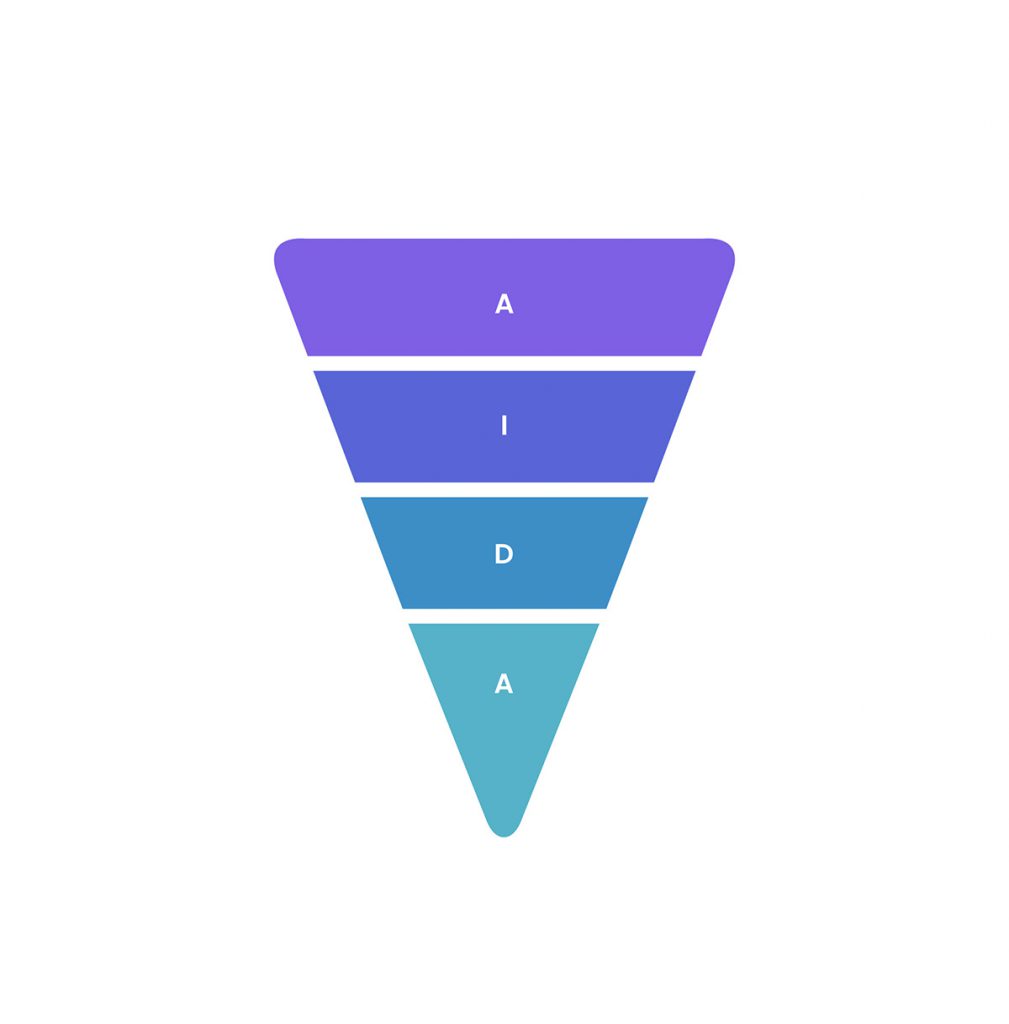
We’ll walk you through the funnel stage by stage so you have a complete understanding of how it works.
Awareness
During the Awareness stage, potential customers have developed a need for something you offer, but they don’t know your brand exists yet. So the very first task would be introducing your brand to that audience.
Let’s take a look at our product – Mailtrap. Mailtrap is an email sandbox service that allows developers to test emails before the real mailout. We launched an SEO-optimized landing page with a blog to introduce Mailtrap to the audience and help potential customers find out about it. We regularly publish articles on our blog and on external sites, record podcasts and videos to spread the word about the tool.
Interest
To ignite people’s interest in our product, we added information about the issues a person/company can solve using Mailtrap, explained how fast it is to set it up, and described how different teams can benefit from it. We also posted feedback from existing happy customers to increase people’s trust in the product.
Desire
At this stage, potential customers start leveraging their possible decision and are likely to compare our service with other tools out there. They show some intent to purchase and may check reviews, compare pricing policies, and watch videos about the product.
Action
Finally, a customer proceeds to the signing-up form and fills it in.
This is the classical representation of the traditional AIDA funnel. Yet, its modern version is commonly extended with L – Loyalty. Modern businesses heavily rely on customer retention and repurchases. So, we decided to add another step to our funnel to satisfy customers and make them loyal.
Loyalty
We set some additional steps to nudge customers to refer a friend or upgrade their subscription plan to the paid version for this stage. The incentive, in our case, is a more advanced functionality.
5As framework
The 5As framework was created by Philip Kotler, a professor of international marketing and a famous author. Philip took the AIDA framework and modified it. His framework consists of the following stages:
Awareness. The stage where potential customers discover a product or service.
Appeal. The stage is characterized by the growing interest of the target audience in an offer. At this stage, potential users want to know the characteristics of a product, the conditions of a provided service, etc.
Ask. During this stage, potential customers would actively research the information about the offering. They may check blog posts, contact managers, or read users’ feedback. People usually have objections before the purchase. You can close them using such social proofs as users’ testimonials, certificates, guarantees, rewards, etc.
Act. If all the objections are closed, a person may purchase a product or service.
Advocate. If the purchase was a success and customers are fully satisfied, they are very likely to return to a vendor more and more. Such customers become loyal and recommend their purchase to friends and colleagues.
AARRR framework
The AARRR framework was offered by Dave McClure. Nowadays, it’s one of the most widely adopted funnel frameworks in the modern tech and startup industry. The abbreviation stands for Acquisition, Activation, Retention, Revenue, and Referral.
To better understand this type of funnel, let’s take a look at our product Coupler.io – a handy data integration tool.
The application of this framework looks like this. First of all, we need to acquire people who will request the product. Then, at the activation stage, we want them to engage with the product features, and help them understand the value it provides.
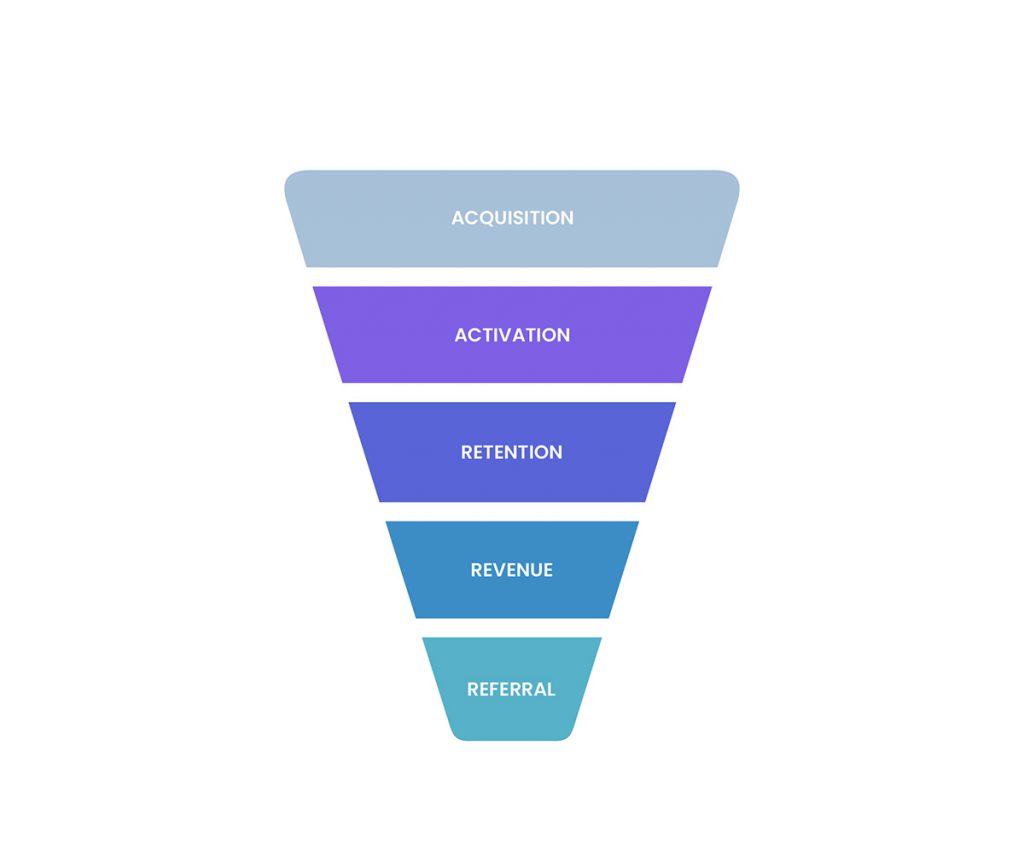
Next, as for the retention part, we want users to come back and reach a certain limit where they would need to subscribe to use the product at its full potential. And another R here stands for revenue. When the user decides to subscribe to a paid plan, we start getting revenue from their subscription. That revenue depends on their lifetime value (LTV) – basically, how long they will remain subscribed to our product.
Last but not least, we also have the referral stage at the bottom of the funnel, where we want users to bring as many other new subscribers as possible.
For the AARRR model to be effective, we need to focus on funnel metrics. Metrics help to measure volumes and conversion rates from stage to stage. They tell us how our efforts are performing through the customer journey and help identify both bottlenecks and opportunities.
Check out our guide on making product improvements, where we explained how we use the AARRR framework to analyze Mailtrap and Coupler.io and improve sales.
Let’s see how this funnel is transformed after we apply metrics alongside the previously determined steps.
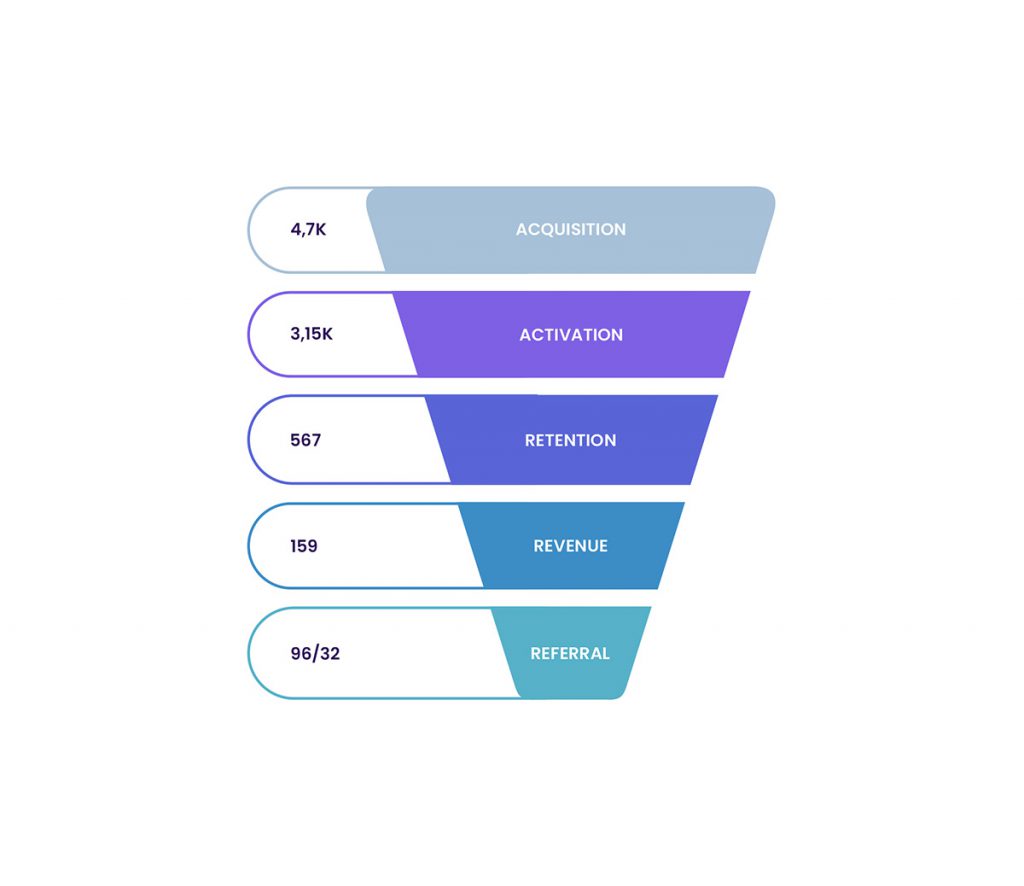
Now it’s not just a simplified customer journey visualization but a powerful and insightful tool that could help gather actionable insights to scale and grow your business.
There are so many other funnel frameworks that you could find on the internet, but the majority mimic the first two frameworks we discussed above. However, businesses nowadays prioritize building long-term relationships with their existing customers over getting as many new leads as possible to enter their funnels.
This trend led to an extended hourglass framework where whatever happens after the initial purchase is being reviewed just as thoroughly as potential customers are nurtured before they pay for the first time. Such a funnel looks more like a jigger rather than a martini glass.
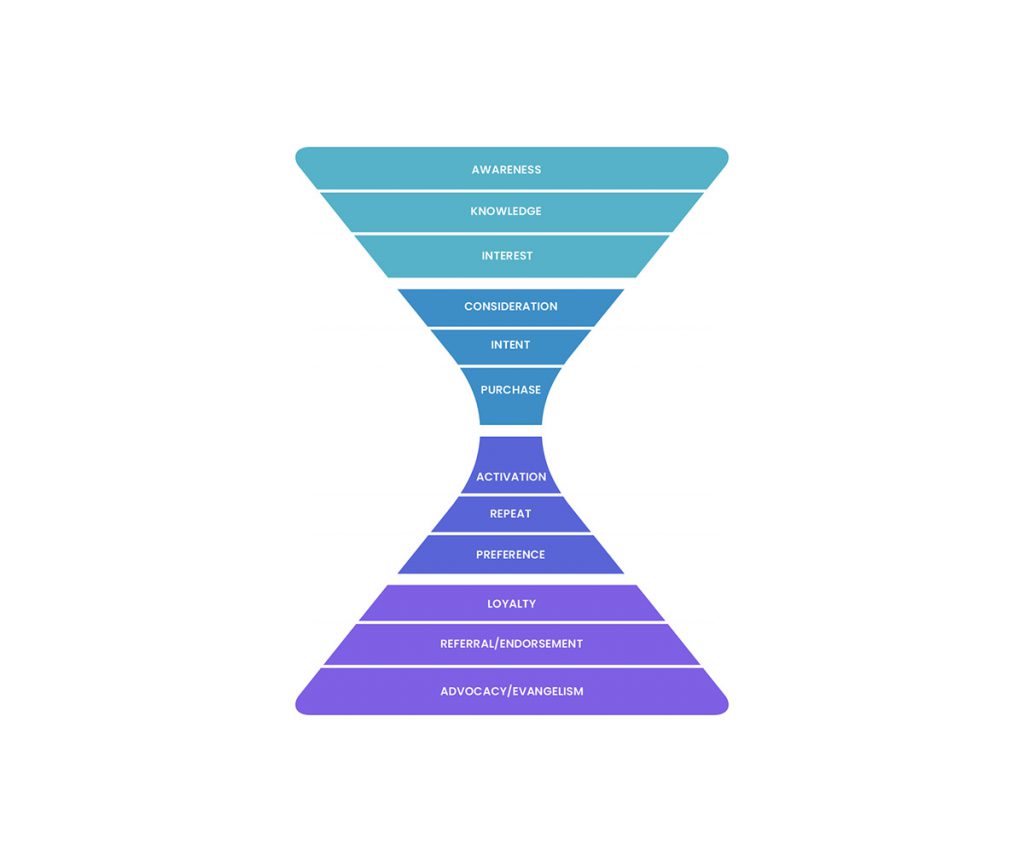
However, the game-changing approach that’s been trending in recent years is treating your customer’s journey not as a funnel but as a cycle or loop.
McKinsey & Company were one of the first who came up with the idea that the initial purchase experience influences not only whether the client will likely come back and repurchase, but their feedback also impacts other customers’ paths and decision-making processes.
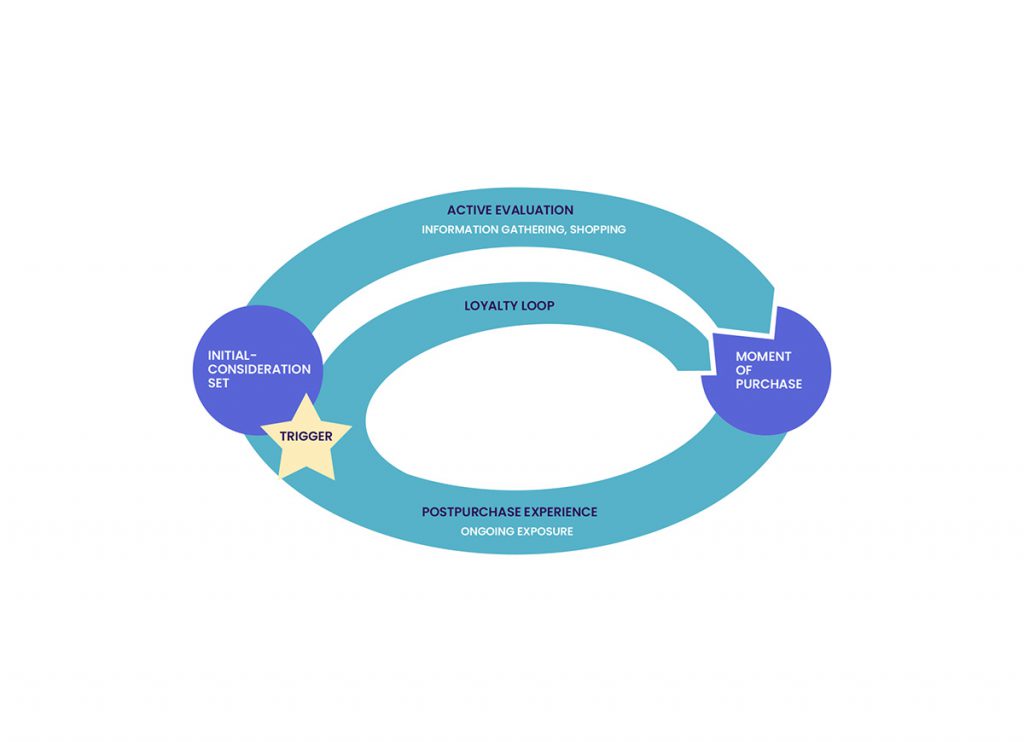
According to Brian Belfour, a growth expert, and his partners from Reforge, funnels were a great starting point. However, they have their downsides as well.
For example, companies build their structure so that different departments are responsible for specific funnel stages. And they optimize their key metrics at the expense of each other. Another issue is that investing more and more resources into putting more at the top to get more at the bottom is unsustainable. The market size is limited.
The idea of growth loops is about creating closed systems “where the inputs through some process generates more of an output that can be reinvested in the input.” Overall, loops seem to be a great next-level tool that helps you to:
get rid of functional silos,
keep your teams on the same page,
find growth opportunities by understanding how one cohort of users leads to another.
The only disadvantage of the loop approach is that determining the growth loops for your product is not easy and straightforward. You would need to dig into loads of data about your users’ behavior and probably have a great scalable product to spot such patterns among your clients’ actions. Nevertheless, it’s something worth thinking about and looking for continuously after creating a regular conversion funnel.
The recap
The funnel concept is about breaking down your clients’ journey into steps and then tracking and improving how well they convert one into another. Marketing Funnels help gather insights about your customers, identify bottlenecks and growth opportunities, as well as receive alerts on any positive and negative changes.
There are numerous funnel concepts, but they share the same stages at the macro level: awareness, consideration, and decision. The most popular funnel framework which has been around for over a century is AIDA, or, it’s better to say AIDAL, which is more up-to-date. Companies in the modern tech and start-up industries prefer the AARRR framework. However, a more beneficial alternative to building funnels is identifying growth loops. We suggest having a basic funnel setup anyways but keep looking for a loop connection between your funnel outputs and inputs.
Thanks for reading! Let me know how you plan your Marketing efforts and brand funnel. :)
Originally posted on Railsware's blog.
